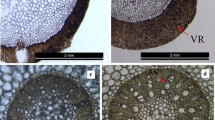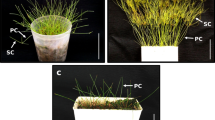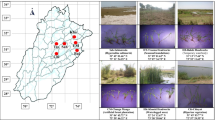Abstract
As storage organs for water and nutrients, pseudobulbs play an important role in the survival of orchids. However, the differences in morphological and physiological responses of pseudobulbs to drought stress between epiphytic and terrestrial orchids remain undefined, and little is known about the physiological imparity of different-aged pseudobulbs. We investigated the anatomy and changes in physiology of pseudobulbs in an epiphytic orchid (Cymbidium tracyanum) and a terrestrial orchid (C. sinense) and compared their responses and recovery during and after periods of drought stress. In particular, “ramets severance treatment” and “multiple leafless pseudobulbs treatment” were applied for C. tracyanum to verify the utilization strategy for the stored water. When compared with C. sinense, the pseudobulbs of C. tracyanum have larger water-storage cells and higher water content, and the enhanced water storage of C. tracyanum can be used and recovered more rapidly. And they had more flexibility in shifting stored nonstructural carbohydrates. The remarkably high concentration and different change trends of abscisic acid (ABA) between different-aged pseudobulbs under drought stress were only found in C. tracyanum. When pseudobulb age was considered, the stored water and carbohydrate changed more rapidly in the youngest pseudobulbs of both species in response to stress. Our results indicated that the pseudobulbs differ in their means for coping with drought conditions according to their life form and age. These findings contribute to our understanding about the functional diversification of pseudobulbs and their strategies for ecological adaptations.






Similar content being viewed by others
References
Acevedo E, Badilla I, Nobel PS (1983) Water relations, diurnal acidity changes, and productivity of a cultivated cactus, Opuntia ficus-indica. Plant Physiol 72:775–780
Barrero JM, Piqueras P, González-Guzmán M, Serrano R, Rodríguez PL, Ponce MR, Micol JL (2005) A mutational analysis of the ABA1 gene of Arabidopsis thaliana highlights the involvement of ABA in vegetative development. J Exp Bot 56:2071–2083
Brodribb TJ, McAdam SAM (2013) Abscisic acid mediates a divergence in the drought response of two conifers. Plant Physiol 162:1370–1377
Chapotin SM, Razanameharizaka JH, Holbrook NM (2006a) Baobab trees (Adansonia) in Madagascar use stored water to flush new leaves but not to support stomatal opening before the rainy season. New Phytol 169:549–559
Chapotin SM, Razanameharizaka JH, Holbrook NM (2006b) A biomechanical perspective on the role of large stem volume and high water content in baobab trees (Adansonia spp.; Bombacaceae). Am J Bot 93:1251–1264
Chapotin SM, Razanameharizaka JH, Holbrook NM (2006c) Water relations of baobab trees (Adansonia spp. L.) during the rainy season: does stem water buffer daily water deficits? Plant Cell Environ 29:1021–1032
Chaves MM, Maroco JP, Pereira JS (2003) Understanding plant responses to drought-from genes to the whole plant. Funct Plant Biol 30:239–264
Cribb PJ, Gasson P (1982) Unusual asexual reproduction in the east African orchid, Cynorkis uncata. Kew Bull 36:661–663
de Kroon H, Fransen B, van Rheenen JWA, van Dijk A, Kreulen R (1996) High levels of inter-ramet water translocation in two rhizomatous Carex species, as quantified by deuterium labelling. Oecologia 106:73–84
Dodd IC, Egea G, Watts CW, Whalley WR (2010) Root water potential integrates discrete soil physical properties to influence ABA signalling during partial rootzone drying. J Exp Bot 61:3543–3551
Gessler A, Treydte K (2016) The fate and age of carbon-insights into the storage and remobilization dynamics in trees. New Phytol 209:1338–1340
Hartmann H, Trumbore S (2016) Understanding the roles of nonstructural carbohydrates in forest trees—from what we can measure to what we want to know. New Phytol 211:386–403
He J, Tan BHG, Qin L (2011) Source-to-sink relationship between green leaves and green pseudobulbs of C3 orchid in regulation of photosynthesis. Photosynthetica 49:209–218
He J, Norhafis H, Qin L (2013) Responses of green Leaves and green pseudobulbs of CAM orchid Cattleya laeliocattleya Aloha case to drought stress. J Bot 2013:9
Hew CS, Yong JWH (1994) Growth and photosynthesis of Oncidium ‘Goldiana’. J Hortic Sci 69:809–819
Jang JY, Kim DG, Kim YO, Kim JS, Kang H (2004) An expression analysis of a gene family encoding plasma membrane aquaporins in response to abiotic stresses in Arabidopsis thaliana. Plant Mol Biol 54:713–725
Kaldenhoff R, Kölling A, Richter G (1996) Regulation of the Arabidopsis thaliana aquaporin gene AthH2 (PIP1b). J Photochem Photobiol B 36:351–354
Kaldenhoff R, Ribas-Carbo M, Flexas J, Lovisolo C, Heckwolf M, Uehlein N (2008) Aquaporins and plant water balance. Plant Cell Environ 31:658–666
Kaplan F, Guy CL (2004) Amylase induction and the protective role of maltose during temperature shock. Plant Physiol 135:1674–1684
Krasensky J, Jonak C (2012) Drought, salt, and temperature stress-induced metabolic rearrangements and regulatory networks. J Exp Bot 63:1593–1608
Li MH, Xiao WF, Shi P, Wang SG, Zhong YD, Liu XL, Wang XD, Cai XH, Shi ZM (2008) Nitrogen and carbon source–sink relationships in trees at the Himalayan treelines compared with lower elevations. Plant Cell Environ 31:1377–1387
Li JW, Chen XD, Hu XY, Ma L, Zhang SB (2017) Comparative physiological and proteomic analyses reveal different adaptive strategies by Cymbidium sinense and C. tracyanum to drought. Planta 247:69–97
Liu FH, Liu J, Yu FH, Dong M (2007) Water integration patterns in two rhizomatous dune perennials of different clonal fragment size. Flora 202:106–110
Liu Z, Chen L, Liu K, Li L, Zhang Y, Huang L (2009) Climate warming brings about extinction tendency in wild population of Cymbidium sinense. Acta Ecol Sin 29:3443–3455
Lu HZ, Liu WY, Yu FH, Song L, Xu XL, Wu CS, Zheng YL, Li YP, Gong HD, Chen K, Li S, Chen X, Qi JH, Lu SG (2015) Higher clonal integration in the facultative epiphytic fern Selliguea griffithiana growing in the forest canopy compared with the forest understorey. Ann Bot 116:113–122
Luo Y, Jia J, Wang C (2002) A general review of the conservation status of Chinese orchids. Chin Biodivers 11:70–77
Martin CE (1994) Physiological ecology of the Bromeliaceae. Bot Rev 60:1–82
Mondragón D, Durán R, Ramírez I, Valverde T (2004) Temporal variation in the demography of the clonal epiphyte Tillandsia brachycaulos (Bromeliaceae) in the Yucatán Peninsula, Mexico. J Trop Ecol 20:189–200
Nagel OW, Konings H, Lambers H (1994) Growth rate, plant development and water relations of the ABA-deficient tomato mutant sitiens. Physiol Plant 92:102–108
Ng CKY, Hew CS (2000) Orchid pseudobulbs—’false’ bulbs with a genuine importance in orchid growth and survival! Sci Hortic 83:165–172
Nobel PS (1976) Water relations and photosynthesis of a desert CAM plant, Agave deserti. Plant Physiol 58:576–582
Nobel PS (1977) Water relations and photosynthesis of a barrel cactus, Ferocactus acanthodes, in the Colorado desert. Oecologia 27 (2):117–133
Ogburn RM, Edwards EJ (2010) The ecological water-use strategies of succulent plants. In: Kader JC, Delseny M (eds) Advances in botanical research. Elsevier, Amsterdam, pp 179–225
Parent B, Hachez C, Redondo E, Simonneau T, Chaumont F, Tardieu F (2009) Drought and abscisic acid effects on aquaporin content translate into changes in hydraulic conductivity and Leaf growth rate: a trans-scale approach. Plant Physiol 149:2000–2012
Seifter S, Dayton S, Novic B, Muntwyler E (1949) The estimation of glycogen with the anthrone reagent. Biochemistry 25:191–220
Shinozaki K, Yamaguchi-Shinozaki K, Mizoguchi T, Urao T, Katagiri T, Nakashima K, Abe H, Ichimura K, Liu Q, Nanjyo T, Uno Y, Luchi S, Seki M, Ito T, Hirayama T, Mikami K (1998) Molecular responses to water stress in Arabidopsis thaliana. J Plant Res 111:345–351
Sinclair R (1983) Water relations of tropical epiphytes: II. Performance during droughting. J Exp Bot 34:1664–1675
Stancato GC, Mazzafera P, Buckeridge MS (2001) Effect of a drought period on the mobilisation of non-structural carbohydrates, photosynthetic efficiency and water status in an epiphytic orchid. Plant Physiol Biochem 39:1009–1016
Stoll M, Loveys B, Dry P (2000) Hormonal changes induced by partial root zone drying of irrigated grapevine. J Exp Bot 51:1627–1634
Tardieu F, Davies WJ (1993) Integration of hydraulic and chemical signaling in the control of stomatal conductance and water status of droughted plants. Plant Cell Environ 16:341–349
Tardieu F, Simonneau T (1998) Variability among species of stomatal control under fluctuating soil water status and evaporative demand: modelling isohydric and anisohydric behaviours. J Exp Bot 49:419–432
Todaka D, Matsushima H, Morohashi Y (2000) Water stress enhances β-amylase activity in cucumber cotyledons. J Exp Bot 51:739–745
von Arx G, Arzac A, Fonti P, Frank D, Zweifel R, Rigling A, Galiano L, Gessler A, Olano JM (2017) Responses of sapwood ray parenchyma and non-structural carbohydrates of Pinus sylvestris to drought and long-term irrigation. Funct Ecol 31:1371–1382
Zhang Y, Zhang Q, Sammul M (2012) Physiological integration ameliorates negative effects of drought stress in the clonal herb Fragaria orientalis. PLos ONE. https://doi.org/10.1371/journal.pone.0044221
Zhang SB, Dai Y, Hao GY, Li JW, Fu XW, Zhang JL (2015) Differentiation of water-related traits in terrestrial and epiphytic Cymbidium species. Front Plant Sci 6:260
Zhang FP, Sussmilch F, Nichols DS, Cardoso AA, Brodribb TJ, McAdam SAM (2018) Leaves, not roots or floral tissue, are the main site of rapid, external pressure-induced ABA biosynthesis in angiosperms. J Exp Bot 69:1261–1267
Zimmerman JK (1990) Role of pseudobulbs in growth and flowering of Catasetum viridiflavum (Orchidaceae). Am J Bot 77:533–542
Zotz G (1999) What are backshoots good for? Seasonal changes in mineral, carbohydrate and water content of different organs of the epiphytic orchid, Dimerandra emarginata. Ann Bot 84:791–798
Zotz G, Bader M (2009) Epiphytic plants in a changing world-global: change effects on vascular and non-vascular epiphytes. In: Canovas FM, Luttge U, Matyssek R (eds) Progress in botany. Springer, Dordrecht, pp 147–170
Zotz G, Hietz P (2001) The physiological ecology of vascular epiphytes: current knowledge, open questions. J Exp Bot 52:2067–2078
Acknowledgements
The authors are grateful to Dr Jia-lin Huang (Key Laboratory for Economic Plants and Biotechnology, Kunming Institute of Botany, Chinese Academy of Sciences, Kunming, China) for his help in the preparation of our experimental materials. And our research was financially supported by the Strategic Priority Research Program of the Chinese Academy of Sciences (Grant No. XDB3101), the National Natural Science Foundation of China (31670342) and the CAS Key Laboratory of Tropical Forest Ecology, Xishuangbanna Tropical Botanical Garden, Chinese Academy of Science (09KF001B04).
Author information
Authors and Affiliations
Corresponding author
Additional information
Communicated by Timothy Bell.
Electronic supplementary material
Below is the link to the electronic supplementary material.
Rights and permissions
About this article
Cite this article
Li, JW., Zhang, SB. Physiological responses of orchid pseudobulbs to drought stress are related to their age and plant life form. Plant Ecol 220, 83–96 (2019). https://doi.org/10.1007/s11258-018-00904-x
Received:
Accepted:
Published:
Issue Date:
DOI: https://doi.org/10.1007/s11258-018-00904-x




